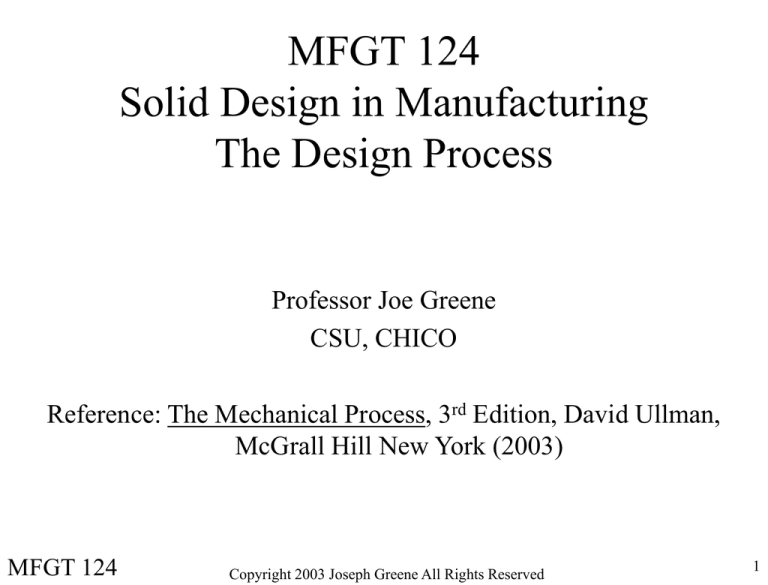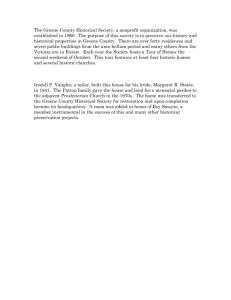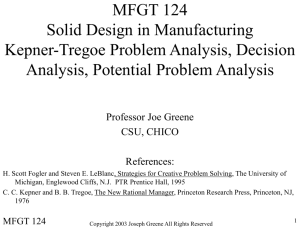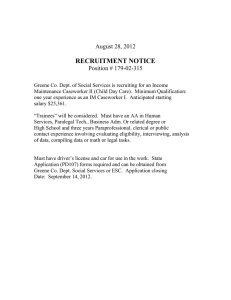MFGT 124 Solid Design in Manufacturing The Design Process
advertisement

MFGT 124 Solid Design in Manufacturing The Design Process Professor Joe Greene CSU, CHICO Reference: The Mechanical Process, 3rd Edition, David Ullman, McGrall Hill New York (2003) MFGT 124 Copyright 2003 Joseph Greene All Rights Reserved 1 Chap 3: Problem Solving • Topics – – – – – – – Introduction Overview of Design Process Designing Quality into Products Simple Design Process Examples Complex Example Communication during the Design Process Sample Design Problem Copyright 2003 Joseph Greene All Rights Reserved 2 Introduction • The design process – Varies from product to product and industry to industry – Generic diagram of activities that must be accomplished for all projects. • Figure 4.1 – Project definition and planning » Establish need for product – Specification definition » What should product do and how will it be tested? – Conceptual design » Build a prototype to prove concept is manufacturable – Product development » Build production parts and a system for mass production – Product Support » Provide means for product to be used » Provide spare parts for returns. Copyright 2003 Joseph Greene All Rights Reserved 3 Introduction • The design process – Always have market input • • • • New type of part that is new to market. Use consumer focus group testing. Develops business case Example, – Stick it notes or walkman or CD burners – Most designs are redesigns of existing products • • • • • Cars have major design changes every 5 to 7 years. Cars have minor changes to fascias, lighting, every 1 to 3 years. Computers are redesigned every 6 months. Make products less expensive and more features. Fix problems with current designs – Cars have changes in the first year of production. » Often times prototype tooling is used at start of production Copyright 2003 Joseph Greene All Rights Reserved 4 Introduction • Break part into major systems and subsystems – Car has 6 major systems • • • • Designed by about 300 designers for GM. Lowers, uppers, engine, transmission, interior, and exterior panels. Assembly plant is laid out in order of build of 6 major systems. Design of car is broken into 6 major systems. – Each system is proken down into subsystems and assemblies and subassemblies. – Example, space shuttle, Fig 4-2 • Rocket booster, Fig 4.3 • Major systems – Sub systems Copyright 2003 Joseph Greene All Rights Reserved 5 Major Systems • Space Shuttle is broken down into smaller components. – Major Systems – Tree Diagram • Each sub system is broken down further to major assemblies. • Each major assembly is broken down further to sub-assemblies. • Each subassembly is broken down further into individual parts. – Engineers are typically responsible for a sub-assembly or two and several parts. – Designer is given a few parts to design. • All parts and assemblies have to be designed to fit together to form major assemblies and systems. – Problems can occur if a redesign in on part does not get changed in another mating part in the subassembly. • One designer has an older subassembly information than another designer. • Example, GM Camaro bumper beam not fitting with rails changes, – Solution: Use product data management to coordinate versions of parts. • Designer is automatically sent the latest drawing information when the designer opens the model. Copyright 2003 Joseph Greene All Rights Reserved 6 Project Planning • Example of Redesign – Shuttle has reusable boosters • Before each launch – Booster is disassembled, repacked with fuel, shipped to launch site, and assembled in field. – Field joints were used to fasten segments together. – Changes in materials or design have to be updated to master design. • Project planning – Process- Fig 4.1 – Planning is important • Chief engineer and product development team meet every week and major systems groups give status report (timing, budget, performance) • Resource requirements – What funding and personnel are needed in near future. • Timing and Cost – 15 people worked on design of field joints of rocket boosters for 1 year. – Hundreds of GM engineers work on a car program over 4 years. Copyright 2003 Joseph Greene All Rights Reserved 7 Specs Definition • Specs Definition – Federal requirements • Bumpers must be 2.5 MPH for cars and 0 MPH for trucks. • Canadian requirements are 5 MPH with some damage OK. – Customer requirements • Want no damage to vehicle in low speed collisions (< 10 MPH) – Company requirements • Bumpers must survive 5 MPH impact with no damage for cars and 2.5 MPH for trucks. – Specifications are written to meet the company requirements. • Bumper must maintain defection less than 130mm and maintain a load of 8,000 pounds without breaking. • Bumper must survive two car hits at 5 MPH and one crash into the wall at 5 MPH. • Bumper must survive room temperature impact and one at –40F. Copyright 2003 Joseph Greene All Rights Reserved 8 Conceptual Design • Most designs start with a conceptual design. – Designs can start on paper with a back-of-the-napkin design or in CAD in sketch mode. • Brainstorming session proposes several designs. • Designs are ranked in order of those best meeting requirements. • Conceptual design is developed to prove that idea works and is best. – Functional prototype is produced and tested with some of the important functional requirements. – Quality is estimated. – Costs are estimated. – Timing is estimated to produce part. – Conceptual design will lead to a Go – No Go decision. • Go decision- money is requested and approved, resources are identified, timing is established, project requirements are finalized. • No-go decision- Project is shelved and no resources are provided. – Example, GM Camaro program was cancelled in 1985 and then restarted in 1987. – It takes 5 years to design a car. 4 years after car program is approved. Copyright 2003 Joseph Greene All Rights Reserved 9 Product Development • Puts concept into production. – Develops the part into a production system. – GM has 4 phases to develop a car or truck • Phase 0- develop functional prototype that meets performance on a per part basis. – Business case is developed and $$ are approved for programs, typically $300M to $5 Billion. – Tools are ordered. Steel stamping dies take 12 months to make; plastic molding tools take 6 months to make. • Phase 1- develop systems that meet performance requirements on production tools and materials. – Production plant is identified and production parts are produced in small batches. – Cars are tested for final safety testing. • Phase 2- develop plant production system to produce car in the assembly plant. – Layout of assembly plant is changed to new car or truck line at costs of $200M to $800M. – Limited cars are produced and market tested. • Phase 3- start of production at line speed of 1 car per 60 seconds. – Get first saleable vehicle. Copyright 2003 Joseph Greene All Rights Reserved 10 Product Support • Support is needed for the design. – Manufacturing and assembly support. • Meeting quality targets like ISO 9003. • Quality workshops and clinics. • Design changes in production plants. – Sales and marketing support. • Parts are provided for early showroom and customer clinics. – Spare parts and warranty support. • Provide parts and design for years after production stops to supply spare parts to customers wanting to repair or replace item. – GM requires vendors to supply parts up to 10 years after car program ends. – Engineering support • Engineering changes during production that make the part cheaper or have higher quality. Copyright 2003 Joseph Greene All Rights Reserved 11 Product Quality • Designing quality into parts – Quality cannot be manufactured or inspected into a product, it must be designed into it. • Old school: – Quality was to measure the quality by inspecting the parts and see what the problems are and then make changes to production system. • New school: – Quality is designed into the part by having concurrent engineer where the design is approved by a cross-functional team. • More effective to design quality into a product than measure it later. • Better to make design changes early in product development than later. • Example, – US car makers versus Japanese car makers. – Figure 4.5 – Best practices in design. • Table 4.1 Copyright 2003 Joseph Greene All Rights Reserved 12 Simple Design Example • Simple Design Example Copyright 2003 Joseph Greene All Rights Reserved 13 Complex Design Example • Complex Design Example Copyright 2003 Joseph Greene All Rights Reserved 14 Communication • Communication Copyright 2003 Joseph Greene All Rights Reserved 15



